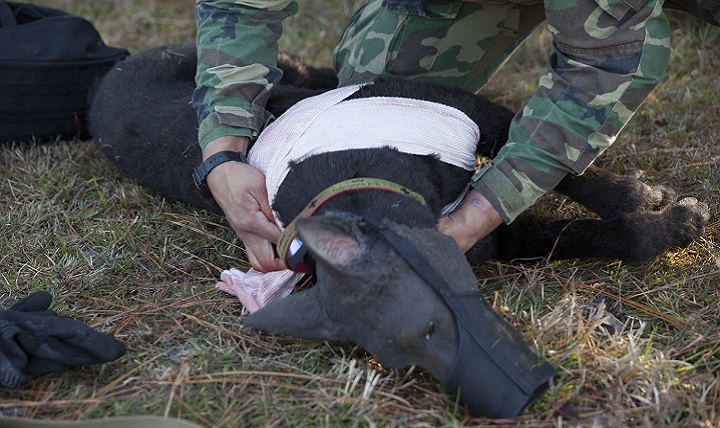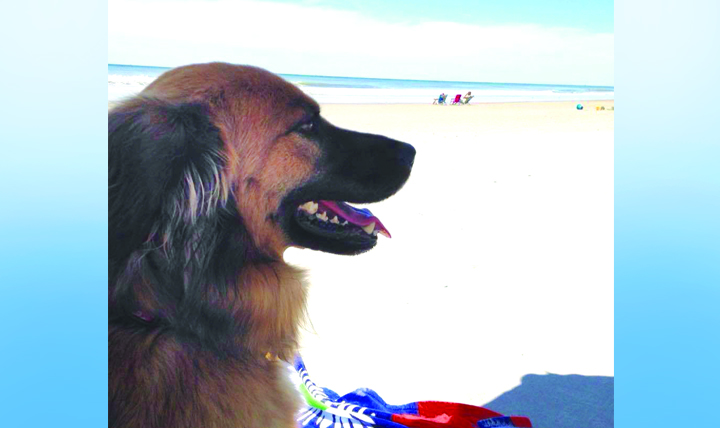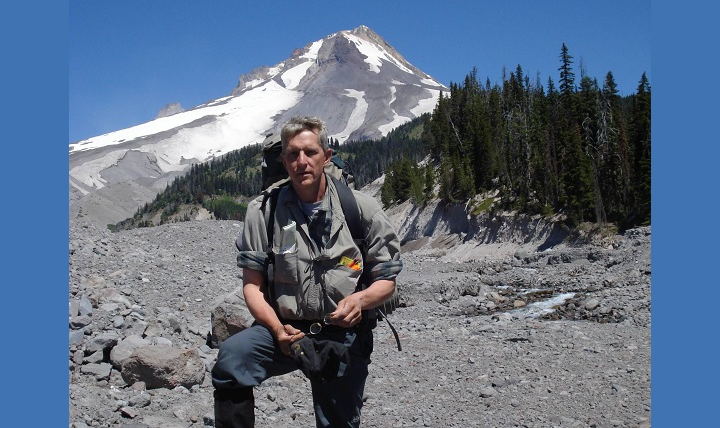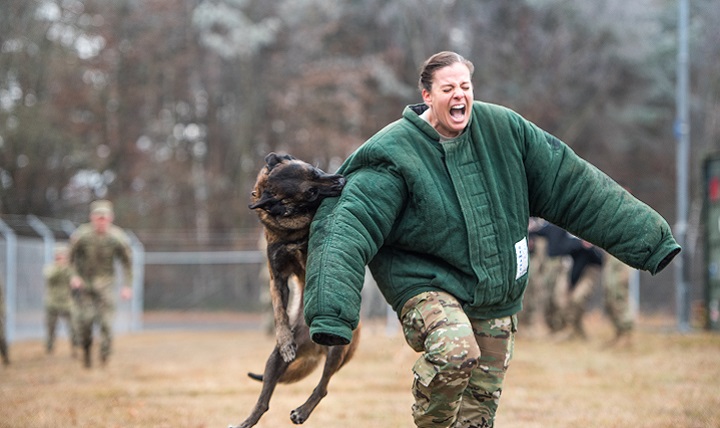
Partnerships increase MWDs capabilities

Air Force Staff Sgt. Aaron Catron, 380th Expeditionary Security Forces Squadron military dog handler, keeps his MWD Morty calm while Army Capt Theresa Hubbell, Area Support Group Kuwait Camp Arifjan veterinary officer in charge, shows Air Force Staff. Sgt. Kristin Niemi, 380th Expeditionary Medical Group medical technician, spots where medical procedures can be performed during basic preventative medical service training, Nov. 27, 2018, at Al Dhafra Air Base, United Arab Emirates. Due to the distance of the veterinary clinic in Kuwait and the services available for MWD at ADAB, Hubbell visited ADAB to perform a quarterly inspection of the MWDs and their living quarters, and provided training for the handlers and Emergency Medical Technicians. (U.S. Air Force photo by Tech. Sgt. Darnell T. Cannady)
AL DHAFRA AIR BASE, United Arab Emirates — The bond between a military working dog handler and the military working dog is vital to securing Al Dhafra Air Base, United Arab Emirates, and protecting its deployed members. To ensure this relationship is effective, partnerships were formed between the 380th Expeditionary Medical Group, 380th Expeditionary Security Forces Squadron military dog handlers, and the veterinary staff at Camp Arifjan, Kuwait to provide basic preventative medical service training for the MWDs.
“Part of our mission is providing veterinary support to the ADAB working dogs,” said Army Capt. Theresa Hubbell, Area Support Group Kuwait Camp Arifjan veterinary officer in charge. “We came over here and provided basic military working dog health training to the health providers. They expressed their willingness to do so and their leadership wanted us to follow up with some training.”
Due to the distance from veterinary clinic in Kuwait and the services available for MWD at ADAB, Hubbell visited ADAB to perform a quarterly inspection of the MWDs and their living quarters, and provided training for the handlers and Emergency Medical Technicians.
“The nearest civilian vet clinic that we have a relationship with and can adequately support these dogs is located about 45 minutes away,” said Hubbell. “In the case of a true emergency [the medical group] health providers would be expected to respond to that situation and stabilize the animal.”
Training between these different squadrons provides alternative medical options for the MWDs.
“This training is important because we don’t have the services available like stateside bases or bases in Kuwait,” said Air Force Tech. Sgt. Mark Allen, 380th Expeditionary Security Force Squadron military working dog handler NCOIC. “This training could determine the life and death for these MWDs. They are a huge asset not only for my guys, but for the base.”
“If a MWD were to come in here injured or in need of immediate assistance, we would be able to assist the animal and provide initial care until we can figure out the right place to send the animal,” said Air Force Lt Col. David Grounds, 380th Expeditionary Medical Group chief of medical staff.
The training showed tips for handling MWDs, warning signs to look for, and the types of procedures these 380th EMDG providers can perform in emergency scenarios.
“It was a great experience and eye opening,” said Grounds. “The care that we can give them is very similar to a human patient and I wasn’t aware of how similar it was. I think that we would be well prepared just by the fact that our medical knowledge for human care is transferable to a canine patient and I think it would be a little bit of an easier transition than I expected if needed.”
This training is the first step towards building a better course and increasing the capabilities of the MWDs.
“We’re going to build upon that in the next year,” added Hubbell. “Today was just a basic course, next time we’re hoping to do more of an emergency health saving procedures course.
“This training will give us a better working relationship with the EMTs,” said Allen. “If we ever have a situation where they need to be called upon or we have to bring our dogs here then we know they are comfortable and adequately prepared to handle whatever situation they are faced with.”
Disclaimer: Re-published content may have been edited for length and clarity. Read original post.
DHA-IPM 17-007: Humane Slaughter of Animals in DoD Programs
Policy
This Defense Health Agency-Interim Procedures Memorandum (DHA-IPM), based on the authority of References (a) through (c) and in accordance with the guidance in Reference (d): Provides guidance and describes procedures for the humane slaughter of animals in DoD food procurement and survival training programs and details the tasks and procedures necessary to ensure humane slaughter and compliance with applicable DoD, Federal, State, and local laws and regulations; is effective immediately and will be incorporated into a Defense Health Agency-Procedural Instruction when DoD Directive 6400.04E (Reference (c)) is updated; will expire effective 12 months from the date of issue; and cancels DoD Veterinary Service Activity Policy Memorandum B-003 (Reference (e)).
- Identification #: DHA-IPM 17-007
- Date: 8/6/2018
- Type: DHA Interim Procedures Memorandum
- Topics: Veterinary Service
Making the diagnosis for our furry friends, and more
Article
4/4/2018

How military veterinary pathologists help animals, humans
USNS Mercy deploys in support of Pacific Partnership 2018
Article
3/1/2018

Medical, dental, civil engineering and veterinary teams will partner with each host nation
The Department of Veterinary Science institutionalizes Global Health Engagement training
Article
1/25/2018

The Department of Veterinary Science at the U.S. Army Medical Department Center and School. Health Readiness Center of Excellence, is driving change by preparing Veterinary Corps Officers to plan and execute GHE activities in support of Theater Security Cooperation
Robot dog improves SOF medical practices
Article
1/10/2018

The development of the new “robot dog” came from SOCOM’s desire to improve the current medical training capabilities
Sweltering ‘dog days’ of summer are no walk in the park for household pets
Article
7/11/2017

Heat and other summertime risks for pets
Keep an eye on your pets this Fourth of July
Article
6/28/2017

Fireworks and barbecues may be fun ways for people to celebrate the Fourth of July, but they’re no picnic for household pets
Army veterinarian reflects on unconventional journey to colonel
Article
6/2/2017

Just out of high school and unsure of what to do with his life, a young Ohio man went to a bus depot, handed a ticket agent almost everything in his pocket and said with a smile, “I’ll go wherever this takes me.”
One Health concept highlights collaboration as key
Article
1/24/2017

Experts, including those at the Defense Health Agency’s Public Health Division, are integrating human medicine, animal health and environmental science to prevent and treat the flu, as well as other serious public health threats
Surgical Soldiers get their paws dirty
Article
1/3/2017

Military working dogs are treated with the same urgency as any other wounded Soldier, although they can present different challenges for surgeons, nurses, and medics who are primarily accustomed to human patients
DoD Directive 6400.04E: DoD Veterinary Public and Animal Health Services
Policy
This directive reissues DoD Directive (DoDD) 6400.4 (Reference (a)) to establish policy and assign responsibilities for veterinary public and animal health services in accordance with the authority in DoDD 5136.01 (Reference (b))
- Identification #: DoD Directive 6400.04E
- Date: 6/27/2013
- Type: Directives
- Topics: Veterinary Service
Access to Medical Services Who were Exposed to Rabies in Combat Theater
Policy
- Identification #: N/A
- Date: 11/18/2011
- Type: Memorandums
- Topics: Health Readiness | Public Health | Deployment Health | Veterinary Service





















.png)









No hay comentarios:
Publicar un comentario